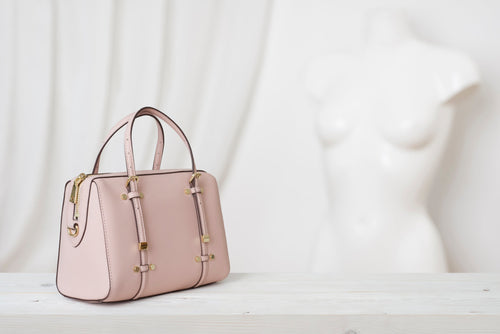Shop designer bags worldwide
Shop designer bags worldwide
All Handbags 2

The Price of Luxury | Why Are Designer Bags So Expensive?
 Lucas Grant Updated On January 29, 2025
5 min read
Lucas Grant Updated On January 29, 2025
5 min read
"Why are luxury bags so expensive?" is a common question from those curious about high-end accessories. As an assistant in the fashion industry, I can provide insight into this matter. This article will explore various explanations for why designer handbags are so expensive.
Introduction to Luxury Bags and Their Prices
The superior quality of luxury bags manifests itself through their longevity and potential value increase. These items are not just functional, they are stylish. They are worth investing in because they are made with top-grade materials and labor. Special construction ensures quality.
The Craftsmanship Behind Luxury Bags
The artisanship behind designer bags is partly a reason for their high prices. Skilled craftsmen spend years perfecting their craft.
They give meticulous attention to every stitch and detail in each handmade bag. These experts' exceptional expertise is evident in the outstanding caliber of the final product.
Manufacturing a luxury bag requires time and patience. It is a process of cutting and sewing individual pieces together by hand.
Once all pieces are joined, the bag is complete. This detailed method creates an unmatched level of quality which machines cannot copy. This is a major factor separating luxury handbags from mass produced bags. It’s safe to say these designer bags can be seen not only as fashion items but also works of art.
The Materials Used in Luxury Bags
Superior craftsmanship and high quality materials are factors that contribute to the high amount of money that has to be paid. Luxury bags comprise top-notch leather, rare exotic skins and precious metals. These exceptional components are sourced from elite global suppliers who use them based on their strength, uniqueness and aesthetic allure.
Getting and working with rare skins like crocodile, alligator, and python for high-end bags is a hard and expensive job. This is also why the things that come out of it are so expensive.
The same is true for making bags out of precious metals like gold and silver. This adds to their uniqueness and value.
Brand Reputation and Exclusive Bags
In order to stay exclusive, many high quality brands choose to limit the production of their handbags annually. One famous example is Louis Vuitton, a well known designer brand that regularly creates new limited editions of various bags. This scarcity drives up demand from collectors who consider such limited edition pieces as worthy investments with great potential value.
Many fashion houses limit the production of their bags to maintain their exclusive status. In more detail, this means that only a limited number of bags are produced each year. Collectors will therefore see them as more valuable and increase their demand.
Celebrity Endorsements and Collaborations
The hype surrounding famous personalities endorsing high-end handbags is one cause of their exorbitant costs. Working together with celebs enables luxury brands to expand their influence in the market, boosting both visibility and sales. A famous example are the Chanel bags. Chanel flap bags have been worn by some of the world's most famous faces, including Audrey Hepburn and Marilyn Monroe.
The presence of partnerships between fashion brands and designers/celebrities is a game-changer for exclusive handbags. These partnerships raise the value of certain bags because of the increased demand. For added allure, certain luxury names distribute personalized or limited edition purses to famous persons only.
In this way, expensive handbags become even more prized possessions and fashion statements.
Marketing and Advertising Costs
In order to maintain their reputation, luxury brands allocate significant funds towards advertising and promotional efforts. Designers utilize high-profile occasions such as fashion shows and celebrity sponsorship in pursuit of increased demand for their products.
By adding marketing and advertising expenses to the cost of of the bags, the final price of the luxury bag increases.
Supply and Demand Economics
When considering any product, the fundamental principles of supply and demand apply equally to luxury bags. In situations where the demand for a particular bag surpasses its availability, it inevitably results in an escalation of its price. Specific bags are strategically limited by luxury brands, such as the well known Hermès Birkin bag. This has as a consequence that augmented prices become a predictable result.
It's easy to think that supply and demand dictate only the retail price of bags, yet this isn't always accurate. Rare or exclusive bags can command a higher value within secondary markets leading them to have an even higher price tag.
High Production Costs
The creation of high end handbags is usually costlier than poducing normal bags. As the manufacturing of each handbags involved manual work, economies of scale are less efficient than for normal bags.
However, this is not the only explanation behind why luxurious satchels have a higher price point compared to ordinary ones.
It's also essential to factor in the salaries of those skilled workers. Furthermore, brand-related overhead expenditures further raise luxury carrier bag prices.
Retailers may charge more for reusable bags due to their expenses during the manufacturing process. Despite this increase in expense, patrons are promised durability as these bags are typically composed of first-rate resources and handiwork.
The Resale Value of Luxury Bags
Investing in a premium purse can offer an advantageous opportunity for it to appreciate in price over a period. Handbags that are unique and can't be replaced can sometimes be sold for a lot more than their retail price. This makes them a valuable tool for collectors.
Some people look at luxury bags as investments because they believe they will increase in value over time. But this isn't always guaranteed.
A variety of elements factor into how much buyers will spend on a used bag. This includes its brand name recognition and design appeal. However, these aren't the only considerations influencing its worth when resold later down the line. Factors such as demand for specific colors and styles come into play.
The market for used designer bags has grown significantly in recent times. We have compiled a complete guide on buying pre-owned designer bags.
Conclusion: Is it Worth the Price?
When it comes to the worthiness of designer bags, it's a subjective matter that hinges on individual preferences and financial constraints. To some people, owning a luxury bag is a symbol of status. Meanwhile, others view it as an outlay in a durable and quality accessory.
The cost of designer bags may appear extremely high. However, it is important to take into account the amount of skill, work and high quality material that is needed. These bags aren't solely practical items, they are masterpieces able to be cherished for a lifetime.
Designer bags differ from regular bags due to their history, unique nature, and superior quality. Therefore, it is important to recognize these attributes and view them as investment items.
Pro Tip: Although designer bags usually come at a high price tag, there can be large price differences between brands, bags and variations. If you goal is to buy a designer bag for investment purpose, we have crafted a compact guide of the best designer handbags for investment. By reviewing the past decade, we show you which bags have appreciated most in price. The guide can be access here:The Top Designer Handbags for Investment: A Decade in Review
Thank you kindly for taking the time to read through this piece. Should it interest you enough to investigate further, we suggest checking out our additional guides. Moreover, we offer an impressive selection of designer purses should you desire an opulent accessory acquisition. We carry these luxury items directly from multiple vendors and retailers which helps to find the best offers all in one place.

Lucas Grant is a blogger at Bolsino.com and a passionate fashion enthusiast with a keen interest in data analytics. Specializing in the intersection of fashion and data, he provides unique insights into the latest trends, market behaviors, and consumer patterns. Lucas uses data to decode the ever-evolving fashion landscape, helping brands and consumers make informed decisions. With each post, discover how data is shaping the future of fashion and how you can stay ahead of the curve.
Leave a comment
Comments will be approved before showing up.
Also in Guides
The Ultimate Guide to Marc Jacobs Tote Bags: Why They’re Taking Over Fashion
by Manuel Peters July 03, 2025 7 min read
Read MoreIs Isabel Marant A Luxury Brand? Your Complete Guide
by Manuel Peters July 02, 2025 7 min read
Read More
The Definitive Radley Handbags Bible: Luxurious & Cherished
by Manuel Peters March 22, 2025 11 min read
Read More

